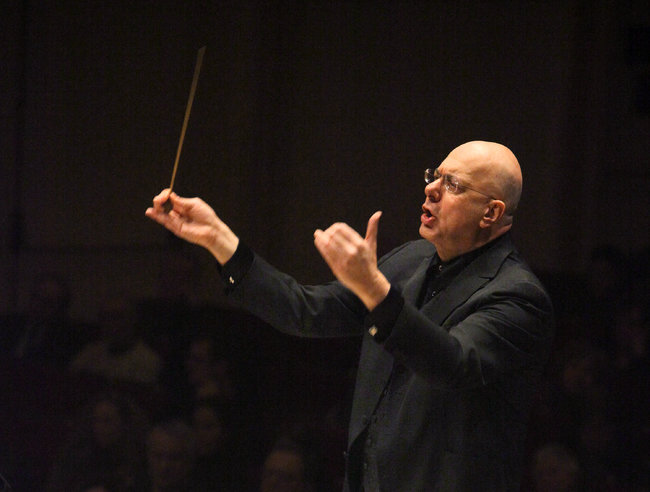Botstein, ASO offer uneven traversal of American “avant-garde”

Leon Botstein conducted the American Symphony Orchestra’s season opener Thursday night at Carnegie Hall. Photo: Cory Weaver
The old avant-garde, it ain’t what it used to be, as the American Symphony Orchestra proved with their season opener at Carnegie Hall Thursday night.
The concert was one of music director Leon Botstein’s theme- and context-rich programs, “New York Avant-Garde.” Superficially, the title seems a natural, since the story of classical music in this city is the story of the twentieth-century avant-garde. Instead, the concert was an uneven and unconvincing exploration of music many audiences in the past regarded as avant-garde.
There was a gap between the concept and the music used to show it. Botstein’s own program notes fell apart in the first paragraph, where he tries to convince the reader that the 1913 International Exhibition of Modern Art at the 69th Regiment Armory was the annus mirabilis for the music, while also admitting that the cataclysm of World War I was the actual impetus for the American avant-garde.
The program was oddly assembled to make either argument, opening with George Antheil’s A Jazz Symphony and the lyrical Poem by Charles Tomlinson Griffes, neither of which is meaningfully avant-garde. Aaron Copland’s Symphony for Organ and Orchestra, Carl Ruggle’s Men and Mountains and Edgard Varèse’s Amériques are more convincing and important.
Antheil was an avant-gardist by self-proclamation (he had a talent for self-promotion and an unlikely biography that included helping Hedy Lamarr develop defense technology during World War II), who made his reputation by writing imitation Stravinsky. He had one notable idea, to mechanize the rhythms from Le Sacre du Printemps in his own Ballet Mechanique, and wrote a lot of mediocre music.
The 1925 symphony is actually a piano concerto, and it starts off as imitation Gershwin then wanders into imitation Petrushka and Le Sacre, with detours into condescending riffs on James P. Johnson and Bubber Miley. The structure is nonsensical and it goes on too long, and there’s something offensive about mocking better musicians who can’t share your own privilege in society. The orchestra and pianist Blair McMillen played with skill and verve.
Griffes is the American Ralph Vaughan Williams, with a lyrical gift but not as much harmonic sophistication. Poem is a lovely compact concerto for flute, with a single theme that moves it through different moods and rhythms. Soloist Randolph Bowman played with a focused sound and fine phrasing.
Botstein’s argument for putting Griffes in the program was that the composer’s interest in non-western music made him a precursor for Henry Cowell. Perhaps, but then why not play The Pleasure Dome of Kubla Khan? And it wasn’t exotic music that made Cowell avant-garde, it was what he did with it. Griffes remained firmly inside the classical tradition.
Copland is an interesting case. He started his career with austere, modernist works, and that style is the core of his intriguing symphony (yet another concerto in disguise), but the piece is already starting to don the clothes of populism. The spookily objective opening movement is balanced with a rousing scherzo that already sounds like one of his ballets to come. It’s a transitional piece, three good movements that aren’t completely integrated. The orchestra was a little slack at times in the scherzo and in Copland’s cross-rhythms in the finale, but the soloist Stephen Tharp was excellent throughout.
There were a few more orchestral problems in the second half. Ruggles’ Men and Mountains was played with gravity but also the wrong type of weight, the kind you struggle to push up a hill. But it’s a great piece, and an important example of the American style of the avant-garde. The three movements flow in and out of velvety, dark modal phrases and free atonality, punctuated by chords stacked on top of each other. Even more than Charles Ives, this is the root of the muscular, bracing American symphonic style of the first half of the twentieth century.
Varèse is the essential avant-garde composer. Like Antheil, he worked under the shadow of Le Sacre but pioneered new ideas with skill. He simplified his music down to a hard core of rhythm and timbre and explored it as deeply as possible.
Amériques, heard Thursday in the 1922 revision, is a powerful and mysterious piece that sounds like it was composed yesterday, with pulsing rhythms, cries from the woodwinds, surging brass and strings crashing into each other. He doesn’t use time as the medium through which to develop material. Instead it’s a container to hold information that starts, then stops.
The performance was impassioned, but not ideal. The brass section and woodwinds played with brilliance, but the tension that Varèse builds waxed and waned. Botstein has one way of handling the baton in performance, and much of the music demands the conductor point the rhythms and accents more clearly and forcefully.
There has been an avant-garde as long as there has been music – Ars Nova, C.P.E. Bach, Schumann, Wagner, Debussy – but up until the twentieth century, that vanguard was always absorbed into the classical mainstream. The eschatology of World War I led to the splintering of musical styles as well as a movement to unmoor contemporary music from history. Antheil and Griffes clung to history, Copland abandoned his escape. Ruggles and Varèse were shards, and their music sounds as fresh as if it was written yesterday.
The ASO’s next concert presents Mendelssohn’s Symphony No. 5, 4 p.m. October 27 at Peter Norton Symphony Space. americansymphony.org


